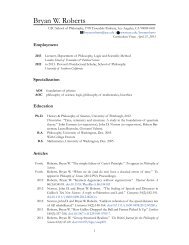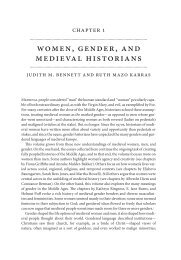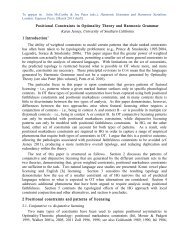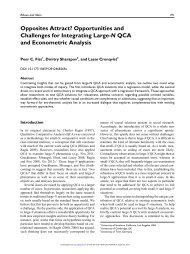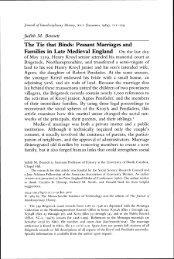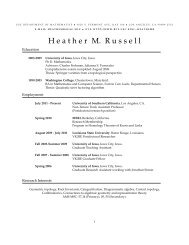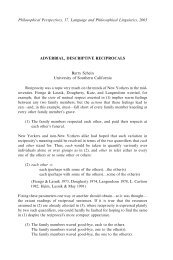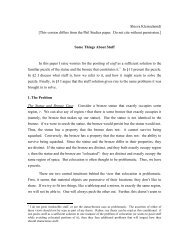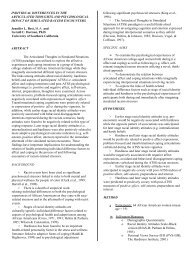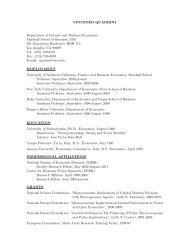The Racial Resegregation of Los Angeles County, 1940-2000
The Racial Resegregation of Los Angeles County, 1940-2000
The Racial Resegregation of Los Angeles County, 1940-2000
You also want an ePaper? Increase the reach of your titles
YUMPU automatically turns print PDFs into web optimized ePapers that Google loves.
1<br />
0.9<br />
0.8<br />
0.7<br />
0.6<br />
0.5<br />
0.4<br />
0.3<br />
0.2<br />
0.1<br />
0<br />
CHART 3: INDEX OF DISSIMILARITY<br />
Index <strong>of</strong> Dissimilarity for Whites, Blacks, Hispanics and Asians<br />
in <strong>Los</strong> <strong>Angeles</strong> <strong>County</strong>, <strong>1940</strong>-<strong>2000</strong><br />
<strong>1940</strong> 1950 1960 1970 1980 1990 <strong>2000</strong><br />
Blacks 0.82 0.82 0.88 0.88 0.76 0.64 0.57<br />
Whites 0.62 0.71 0.64 0.57 0.57 0.57 0.56<br />
Asians 0.57 0.7 0.5 0.44 0.51 0.5 0.51<br />
Hispanics 0.58 0.85 0.56 0.48 0.36 0.41 0.43<br />
Chart 3: “Index <strong>of</strong> Dissimilarity for Whites, Blacks, Hispanics and Asians<br />
in <strong>Los</strong> <strong>Angeles</strong> <strong>County</strong>, <strong>1940</strong>-<strong>2000</strong>,” displays the most commonly used measure <strong>of</strong> “segregation” in<br />
American social science since the 1950s. Based always on a comparison <strong>of</strong> two groups (eg, White vs.<br />
Nonwhites, Blacks vs. Nonblacks), this measure is very easy to interpret. <strong>The</strong> Index <strong>of</strong> Dissimilarity<br />
or “ID” ranges from 0 to 1, and tells us the percentage <strong>of</strong> a given population that would have to<br />
change its residential location in order to even-out the distribution <strong>of</strong> that groups across the<br />
metropolitan space. If Blacks were evenly settled across the entire county, for example, their ID<br />
would be 0 (perfectly integrated). If Blacks only lived in census tracts that were 100% Black, and no<br />
where else, then their ID score would be 1 (perfectly segregated).<br />
Scores <strong>of</strong> 70% or higher are considered to show serious segregation. Blacks in U.S. cities have<br />
shown scores higher than this figure since the Second World War, and yet in many western cities this<br />
figure has come down significantly. Here in <strong>Los</strong> <strong>Angeles</strong> the ID for Blacks has decreased<br />
significantly from the very high 88% in 1960 and 1970 to the relatively moderate 57% in <strong>2000</strong>.<br />
Just as remarkable, however, is how little the ID for Whites has changed: almost not at all since 1960.<br />
<strong>The</strong> figure has remained frozen at 57 or 56 since 1970, which is precisely the same in <strong>2000</strong> as the ID<br />
for Blacks. In other words, the ID also shows us that Whites and Blacks are equally segregated, and<br />
that most members <strong>of</strong> each group would need to move to achieve integration.<br />
<strong>The</strong> ID scores for Hispanics and Asians are also significant. Hispanics are the least segregated racial<br />
group by this measure. Less than half <strong>of</strong> all Hispanics would need to move in order to achieve full<br />
spatial integration. <strong>The</strong>ir score fell from 1950 to 1980, but is clearly on the rise again.<br />
Asians are only moderately segregated, and have remained at the same level <strong>of</strong> segregations by the ID<br />
measure since 1980. About half would need to move to even out the spatial distribution in the county.<br />
Race Contours <strong>2000</strong> –<strong>Resegregation</strong> <strong>of</strong> <strong>Los</strong> <strong>Angeles</strong> <strong>County</strong>, <strong>1940</strong>-<strong>2000</strong> 12<br />
Blacks<br />
Whites<br />
Asians<br />
Hispanics



